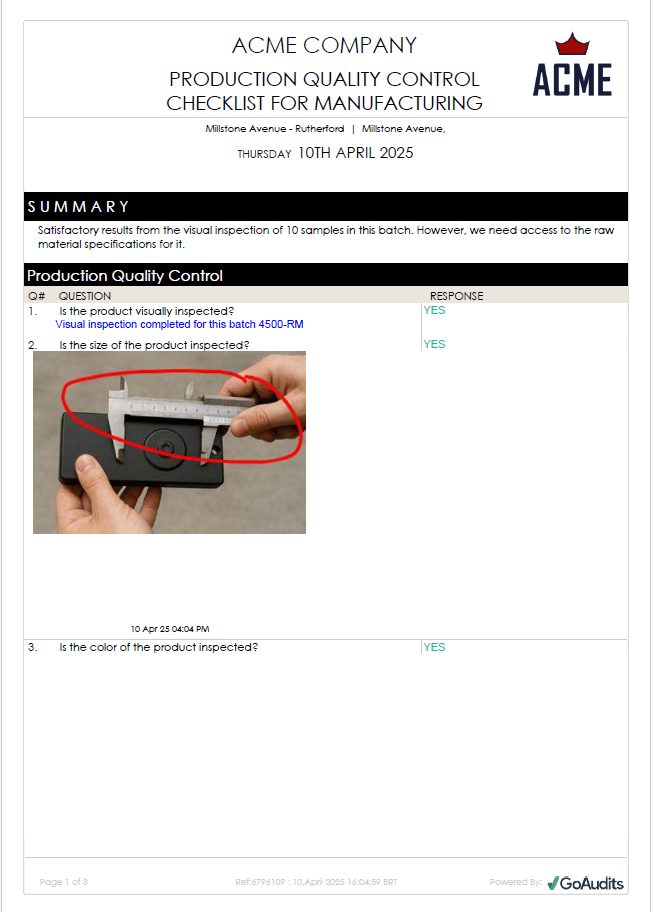Key Takeaways
- Quality inspection reports are crucial for documenting compliance, identifying defects early on, and finding opportunities for continuous improvement.
- Creating QC reports manually is time-consuming and prone to errors, causing delays in initiating resolutions.
- Inspection software like GoAudits allow businesses to perform efficient quality checks, generate and share instant quality control inspection reports, and take prompt corrective actions.
Quality inspection reports are critical in maintaining consistency, accountability, and operational excellence. Whether you are inspecting raw materials, monitoring production processes, or reviewing final outputs, quality control inspection reports provide essential documentation to support decision-making and drive improvements.
Read on to explore essential components of a QA/QC report, the importance of using checklists, and how inspection apps reduce reporting time from hours to just a few minutes.
Importance of Quality Control and Quality Assurance Inspection Reports
A quality control and assurance report is a structured document that presents data demonstrating whether products, processes, or services meet specified requirements. It serves as a tool to monitor and track quality at each production level and shows how well the company complies with internal and external quality standards, such as ISO.
QC reports are vital because they help businesses maintain high-quality standards consistently. Customer loyalty and satisfaction can be adversely affected by subpar products. A well-documented QA inspection report helps identify and address defects at the production stage. This not only prevents customer dissatisfaction but also avoids costly recalls, hefty penalties, and legal liabilities.
Lastly, quality inspection report data is a powerful tool for continuous improvement. Companies can analyze patterns and identify trends to optimize their production processes, reduce waste, and ensure their products meet high-quality standards every time.
Difference Between Quality Control and Quality Assurance
QC focuses on detecting defects in the final product. It’s a reactive process involving inspection and testing to verify if the output meets the required standards after it has been produced. QA, on the other hand, is a proactive approach that focuses on preventing defects from occurring in the first place. It establishes processes and standards to ensure quality throughout the entire lifecycle of a product or service – from design to delivery.
When Do Businesses Need Quality Control Reports?
Businesses typically conduct quality inspections and write/require QC reports at the following stages of the product life cycle:
- Receiving Raw Materials or Components: Before using them for production, a QC report documents whether the supplied goods meet the required specifications.
- During Production: In-process checks help detect deviations early. Quality control inspection reports from these checks confirm that processes are running correctly and identify issues before they escalate.
- Final Product/Service Inspection: This is often the most critical QC checkpoint. A final quality inspection and report attests that the finished good meets all quality standards, specifications, and customer requirements before it reaches the market or client.
- Handling Customer Complaints or Returns: When investigating quality issues reported by customers, historical and newly generated QC reports provide crucial data to understand the root cause of the defect and implement corrective actions.
- Supplier Evaluation: When assessing the performance of suppliers, QC reports offer objective evidence of quality consistency and adherence to agreements.
- Regulatory Compliance: Many industries (like food and pharmaceutical) have strict regulations requiring documented proof of quality control. QC inspection reports serve as essential compliance documentation for audits and legal requirements.
Case Study: How HTS digitized manufacturing quality control audits and reporting leveraging GoAudits.
Essential Components of a Quality Control Inspection Report
While formats can vary, a robust report should consistently include the following essential components to ensure clarity and usefulness:
- Inspection Details: This section captures key information like a unique report ID, the date and time of the inspection, the location where it occurred, and the name of the inspector responsible.
- Product/Process Details: Includes the item name or SKU for products (batch or lot number in case of a process) checked for quality.
- Inspection Checklist & Criteria: This includes the specific checklist used, confirming that the inspection was performed against predefined, objective criteria. This documents exactly what was assessed and provides the detailed basis for the quality assurance.
- Findings & Observations: This core section contains detailed, factual notes from the inspector, describing what was observed, covering both aspects that meet the standards and any deviations found.
- Non-Conformance Details: This section includes a clear description of non-compliances, along with their level of severity.
- Visual Evidence: Inspectors must include supporting evidence, such as photographs, videos, or diagrams, to clearly illustrate and communicate findings related to defects.
- Recommended Corrective/Preventive Actions: Includes suggestions on how to fix the identified non-conformances and prevent the issue from happening again.
- Signatures & Approvals: This includes the inspector and/or manager or supervisor’s signatures confirming inspection completion and indicating review and acceptance.
Case Study: Nissin Foods streamlines quality control inspections and reporting with GoAudits QC software.
Free Quality Inspection Report Template
Here’s an example of a quality inspection report sample for the manufacturing industry.
The above quality control inspection report template is an example of a checklist-based report generated with GoAudits. Depending on the industry and project complexity, there can be multiple quality control checkpoints. This may require several individuals to perform inspections at different instances. In such cases, standardizing becomes a challenge. An inspector may miss out on some specific points, or there may be inconsistencies in final reports, depending on who performs the inspection.
Quality control checklists can solve this problem. You can create custom checklists based on the process requirements, stage of production, and specific quality standards and mandate your inspectors to use them. This will ensure they cover all critical checkpoints and report quality consistently in a standardized manner.
Free Quality QA QC Checklists for Different Industries
Here are a few examples of GoAudits’ quality control and assurance checklists:
- Production Quality Control Checklist for Manufacturing
- Construction Quality Control Checklist
- Packaging Quality Control Checklist
- Warehouse Quality Control Checklist
- Vendor Quality Audit Checklist and Supplier Quality Audit Template
Eliminate Manual Reporting: Create QA QC Reports in Real-time
Drafting quality control reports manually poses serious challenges that can cause delays.
- Laborious and Tedious: Personnel have to type all the data, such as findings, non-conformances, notes, and corrective actions, into a report. Moreover, they attach accurate visual evidence such as photos, videos, and diagrams.
- Inconsistent and Prone to Error: Different inspectors may record information differently, introducing elements of inconsistencies. There may be instances of illegible handwriting, typos, etc.
- Complex Data Analysis: Inspectors spend several hours analyzing quality assurance audit reports to extract insights, spot trends, and calculate defect rates.
- Slower Response Time: Traditional inspections combined with manual reporting offer no scope for businesses to get real-time data. It takes several hours for the report to reach the management, delaying corrective or preventive actions.
- Hidden Costs: Moreover, the significant labor hours spent on manual writing, data entry, compilation, filing, and retrieval represent a substantial operational cost.
A quality inspection app like GoAudits can help you tackle these challenges.
With GoAudits, inspectors can perform quality checks (both online and offline) using their mobile devices and generate instant professional reports that can be shared within the app. In case they encounter a serious defect during inspection, GoAudits allows them to assign corrective action on the spot.
As the Quality Control Manager, you can set up workflows defining who needs to receive the reports for further approvals and final reviews, ensuring nobody wastes time downloading and signing them manually.
You can even initiate corrective/preventive measures, track their progress, and take follow-ups. The best part: you can monitor everything related to quality inspections and reporting through the admin Dashboard.
Case Study: How Woodside Homes leverages GoAudits to increase the efficiency of their quality control processes.
Streamline Quality Inspections and Reporting With GoAudits
GoAudits is a quality inspection software that allows businesses to deliver high-quality products while meeting the safest and highest quality standards. Its scalable features enable managers to streamline QC processes, consistently achieve high quality scores, and deliver excellent products to their customers.
With GoAudits, you can:
- Create custom checklists based on processes, checkpoints, etc.
- Schedule random and systematic quality inspections.
- Conduct efficient checks using the GoAudits mobile app.
- Generate and share instant reports to make sure everyone on the team is updated.
- Initiate prompt corrective actions and monitor their completion.
- Ensure compliance with popular quality standards like ISO.
With a rating of 4.8 stars on Capterra, GoAudits is trusted by some of the biggest names in the industry.
» GoAudits Reviews: Read how companies leverage GoAudits to meet standards in their operations and quality.




